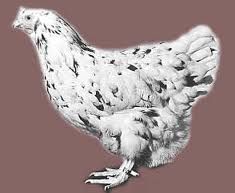I have 5 pullets and one cockerel in the purebred Erminette line. I can't wait for them to multiply. A friend had ordered birds from someone in a northern state. The line is started from the man mentioned in above post that passed away way back when. Idr the state but can ask her. Her family was military transferred to Oklahoma and I got eggs from her birds when I boarded them until she came to get them. I will post a brief "standard" she got from the breeder. They are beautiful birds. I hope to be helping restore the breed also. I already raise heritage Plymouth Rocks and Large Fowl White Cornish, Bantam Dark Cornish and Bantam Red Laced White Cornish. The body of the Erminette should resemble the Plymouth Rock and the Barred Rock can be used to outcross if needed. I have not had to do that. Yet. Above post is the first time I've ever heard that red feathers were acceptable in the breed. In the "standard" (not in APA) it states red leakage is not acceptable. But they are beautiful so I kept them but would be separated when breeding g age. I'm glad because I have two girls that are white with black and red spots, one with red spots, one with blue spots and one with black spots. The cockerel is black spotted. I'll post some better pics when I take them. These pics are a few months ago and it was raining but thats what I found at the moment. You may see Plymouth Rocks in White, Barred, Blue and Black in the pics. There are 7 colors of Plymouth Rock I raise four colors. So far. The lavender splash at front of 2nd pic is a dilute and all went to camp.
View attachment 2367033View attachment 2367028View attachment 2367029p.
View attachment 2366993View attachment 2367007


